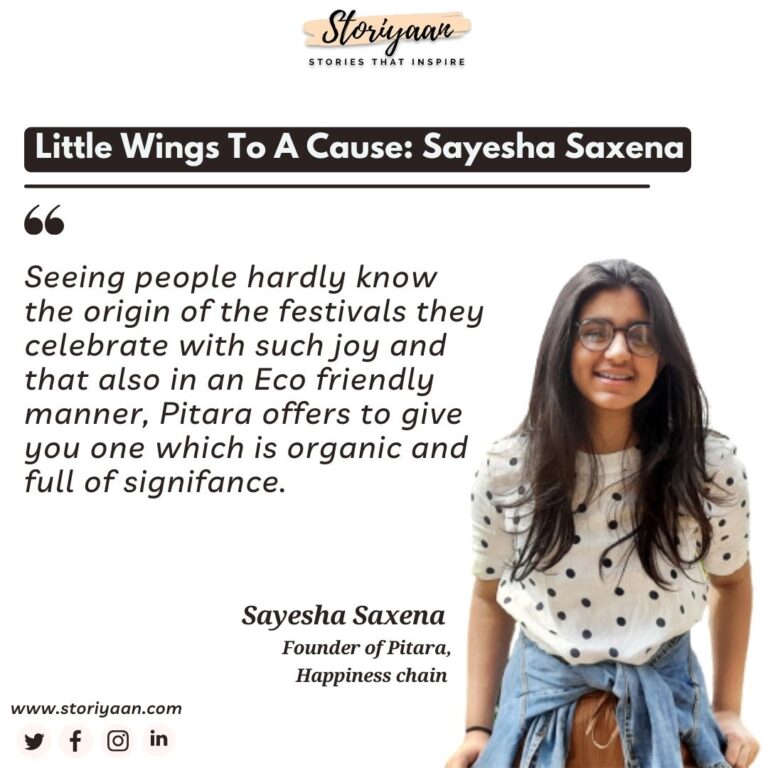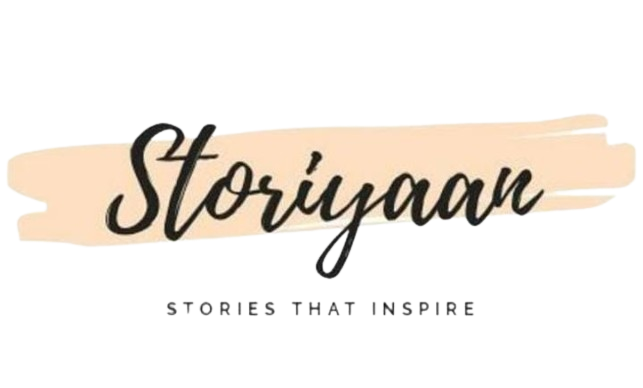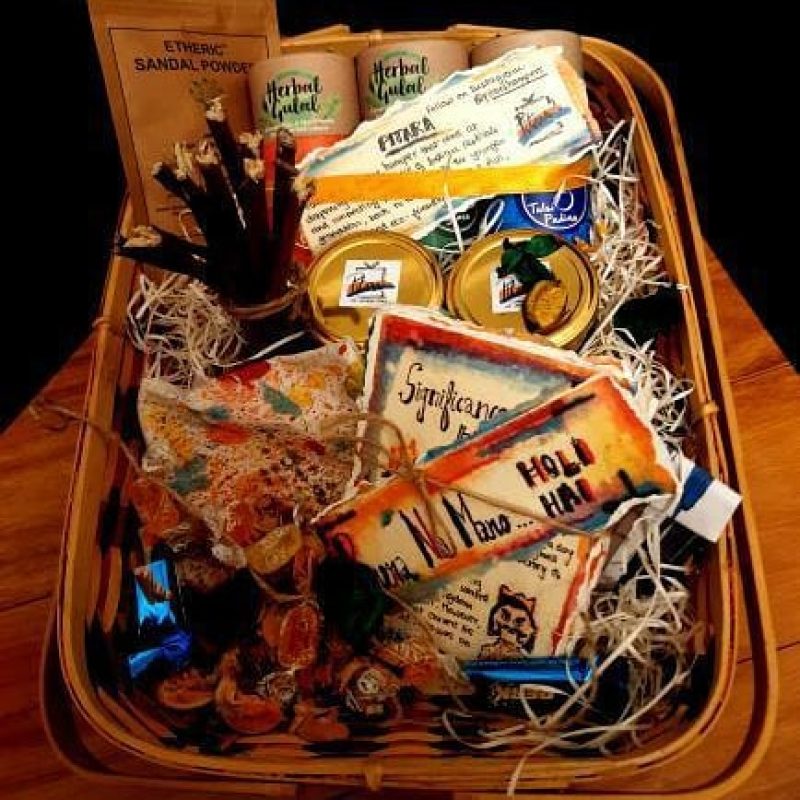There is nothing that a dedicated young mind cannot achieve. Sayesha Saxena is a paragon of success who is championing the cause of reviving the dying stories behind the celebrated Indian festivals. Sayesha is 13 years-old and is a young entrepreneur whose exuberance and love for the fading traditions is making today’s fast-paced world look up and take notice. Her business which is creatively called “Pitara” is about the history and culture that often eludes us but has kept this little mind invested. “Our hamper is a collection of many things – a booklet with stories, recipes of sweets you can make on Indian festivals, ideas to celebrate our events in an eco-friendly and fun way,” says Sayesha.
Read more about this exemplary youngster in this inspiring conversation with Storiyaan.

Interview
Questions and answers
Your idea of starting your venture finds its source in the stories of festivals and dates to your grandmother and parents reciting. How did you conceptualize turning oral stories into artefacts to preserve their heritage?
The main essence of “Pitara” was to share all the stories or reasons behind the various celebrated Indian festivals, and I thought to share these stories through a catchy booklet and to satisfy my creative side, I also tried giving it an appealing, exciting look with hand-drawn illustrations and handwritten texts designed by me. This idea evolved into our “Pitara” hampers.
What were the aspects of these stories that you found most fascinating, and how did you relate to them personally in your daily life?
I feel all stories behind the Indian festivals are engaging and fascinating in their ways. I don’t relate to these stories in my personal life, but I feel there’s a beauty and uniqueness to each story that needs to be preserved as a part of our culture. These stories show us how good conquer evil, or why righteousness is a virtue and so on which are lessons that should never be forgotten.
As a young entrepreneur, how did you gather and mobilize your resources and dig into research materials for the booklets?
For our booklets, I look into different sources for the necessary information – I learned about many traditions from my parents and grandparents, I took a lot of references from the internet. Likewise, we decided to incorporate these important significances of the festivals along with other fun ideas like our ‘Holi Booklet’ contained detailed information about homemade, natural colours. We also state our sources or refer small-scale businesses who are working in creating such natural colours which helps them to get their products to the interested customers.
Your business aims at reviving the history of Indian festivals. However, in a land of multiple religions, what is your strategy to entail all Indian festivals and dig the roots of their origin?
India is a land of multiple cultures, traditions, and languages. We are mainly trying to concentrate and work on the major and the well-known festivals so that a lot more people can connect to their origin and roots. With time, we will also focus on the smaller or relatively unknown festivals or regional events – it is a daunting and thrilling journey.
Tell us the events that led to the nomination of your business “Pitara,” and what were some of the promotional strategies adopted by you?
Our business is a humble attempt at reviving the dying stories behind the most popular Indian festivals; it was a unique initiative that was greatly appreciated. At the same time, I was part of a program known as Young Entrepreneurs Academy (YEA), which helped me a lot both in terms of investment and exposure. This led us to our nomination and I am very pleased that my effort got recognition.
We are trying to grow Pitara very organically. We use social media platforms like Instagram for greater reach and have been featured by many platforms like ‘She The People’. These are some of the promotional strategies that helped us grow.
You sought your friends’ opinion when you first decided to begin “Pitara”. How did their feedback impact your work?
My friends and family helped me in finalizing my products and hamper goods, spread the good word about “Pitara” and brought productive feedback about their opinion on them. They were also my first buyers. I don’t think without their motivation, encouragement and support I would be able to establish my business.
Who or what was your greatest inspiration source when working on the first booklet and what turned out to be your greatest motivation?
Creativity came naturally to me and I loved exploring new things. So when the thought of making such a booklet stuck with me, I jotted down my thoughts and designed the products. So, it was instinctive and not inspirational. My greatest motivation is my mother who is always pushing me forward to do my best.
Since the booklets and novelties were aimed at young readers, what was your strategy to enhance readability and make it more attractive to kids who mostly tend to incline towards picture books?
Children are often not inclined towards books that include copious amounts of text, so, our primary focus was to keep the text light, captivating and use a lot of imagery. The booklet contained many fun facts and activities, which made sure the children remained engaged and interested.
When did you develop awareness for protecting the environment, and could you tell us about the factors that led you to feel so deeply for the cause?
My concern for the environment started from my school, Shri Ram School, Aravali who introduced us to the disastrous effects of Climate Change and instilled a sense of responsibility in us for preserving our Mother Nature.
The fact that we are so recklessly harming the only inhabitable planet, without which we will cease to exist, made me feel so deeply about the cause. Even in our Pitara hamper, we keep all organic products and a packet of seeds to spread this awareness.
What kind of research went into formulating the ideas in your hampers that would enable one to celebrate in an eco-friendly and fun way?
Festivals were always celebrated in eco-friendly ways, it is only recently that we have started using harmful products and equated them with Festive celebrations. I wanted to re-introduce this alternative so I started contacting people who were already learning and working with organic products and got in touch with NGOs who were working towards that end.
What are some of the immediate plans that you have regarding the future of “Pitara” and where do you see yourself in the next 5 years?
“Pitara” recently launched an expansion known as “The Happiness Chain” to help spread joy both online and offline through our hampers and aid in our customer’s mental well-being. Over two years we hope to include the elderly in the production process and the NGOs for sourcing different raw materials from them which will also benefit them financially.
In the next five years, I see myself spreading the environmental cause, planting more trees and expanding our “Pitara stories” to as many festivals and languages as we can cover.
Quick 5
- Your greatest achievement apart from Pitara – Topped my entire grade for two consecutive years in academics
- Your favourite book – The Fault In Our Stars by John Green
- Your favourite festival – Diwali
- One sweet recipe among the ones curated in Pitara that is your absolute favourite – Gujiya from my Grandmother’s recipe
- Your greatest environment champion – Anyone who tries to spread awareness and protects the environment even at the smallest level

The Story of Hair Care Revolution with Traya
From Struggles to Solutions: There’s Hope For Hair with Traya Hair carries emotions, memories, and stories—of the entangled fingers of loved ones, the tug of

